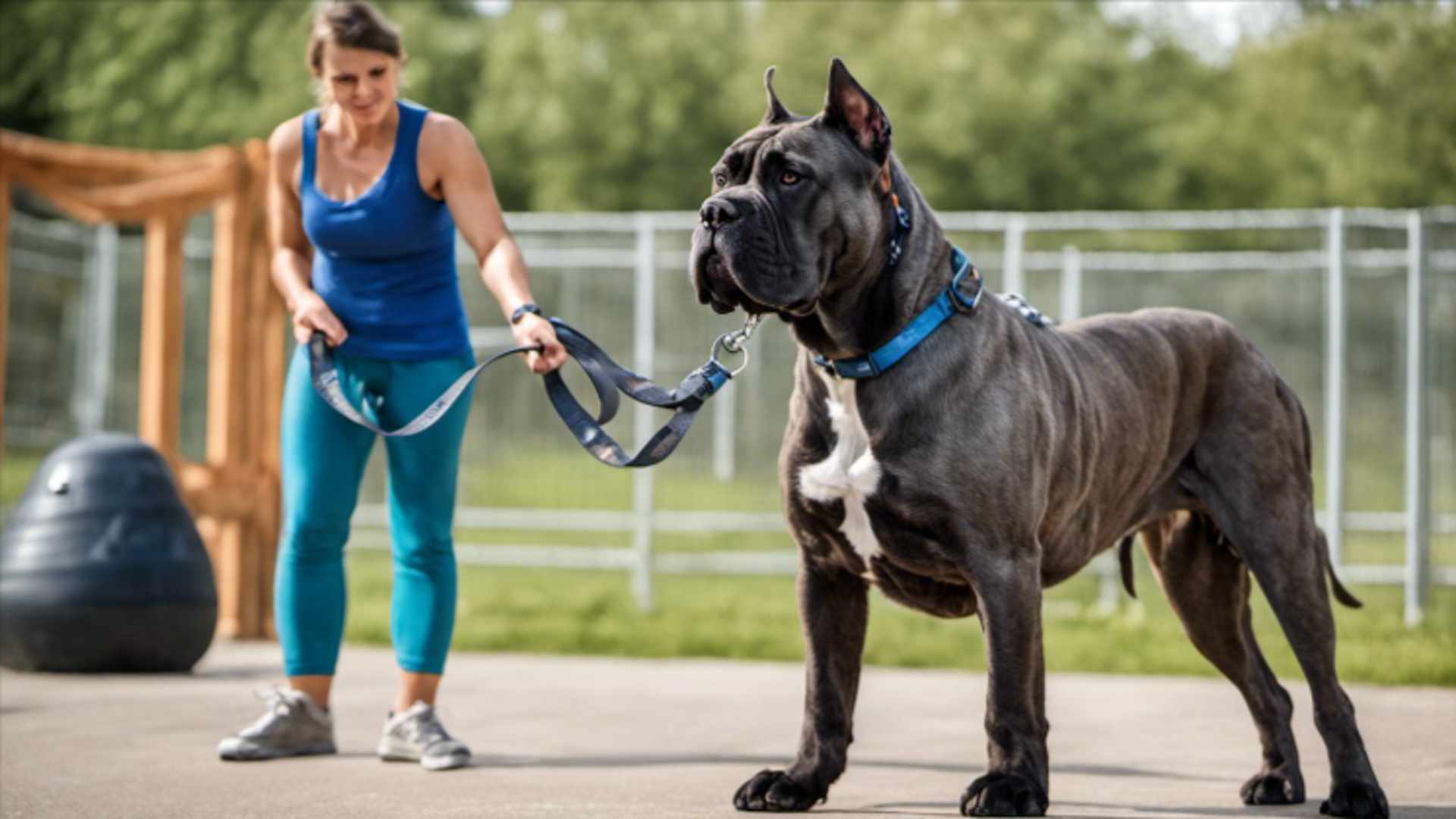If you’re a pet owner, you know that training your dog isn’t always easy. With large and powerful breeds like Cane Corsos, it can seem even more daunting!
We’ve all been told to use a shock collar to help us out when our dogs don’t mind their manners. But do shock collars really work on Cane Corsos?
Although some people use shock collars to train their Cane Corso, they do not work in every situation. Despite what they might promise, these devices do not always guarantee results and can even lead to long-term behavior problems if used incorrectly.
Instead of relying on a shock collar, it is best to use positive reinforcement training methods like clicker training or reward-based training to train a Cane Corso effectively. This approach offers consistent and humane ways to teach your dog how to behave and obey commands.
In this article, we’ll dive deep into this complex issue, exploring the pros and cons of using shock collars on Cane Corsos. We’ll also discuss alternative training methods that may be more effective for this breed.
Ready? Let’s go!
How do shock collars work?
Before we dive into the specifics of using shock collars on Cane Corsos, let’s take a look at how these devices work.
Shock collars are designed to deliver an electric shock to your dog when they misbehave or disobey commands. The shock is usually delivered through two metal probes that make contact with your dog’s skin. The idea is that the shock will be unpleasant enough to discourage the behavior.
Now that we know how shock collars work let’s look at when these devices were first used.
Shock collars were first developed in the 1960s to train hunting dogs. They were designed to be used when verbal commands weren’t enough to get the desired results.
Over time, they have become increasingly popular with pet owners looking for an easy way to train their dogs.
Are shock collars effective for training a Cane Corso?
The effectiveness of using a shock collar for training a Cane Corso is a topic of debate among dog trainers and behaviorists.
Some argue that shock collars can be an effective tool for training and correcting certain behaviors, while others believe they can be harmful and cause negative side effects.
That said, there is no guarantee that a shock collar will work on a Cane Corso. In fact, it could even backfire and lead to more aggressive behavior in some cases.
However, let’s suppose you want to use it. It’s essential to use the lowest possible level of stimulation necessary to achieve the desired behavior and never to use the collar as a form of punishment.
It’s also advisable to consult with a professional dog trainer or behaviorist before using a shock collar on your Cane Corso.
Are shock collars safe for Cane Corso breeds?
Shock collars can be dangerous for Cane Corso breeds if used incorrectly. The shock delivered by the collar can cause physical pain and discomfort, as well as psychological distress. This can lead to long-term behavioral issues such as fear, aggression, and anxiety.
What are the alternatives to using a shock collar on a Cane Corso?
Positive reinforcement training methods such as clicker training and reward-based training are much safer and more effective ways to train a Cane Corso.
These methods focus on rewarding good behavior with treats or praise rather than punishing bad behavior with electric shocks.
These methods are also more humane, as they don’t rely on physical or psychological pain to achieve results. They also help to build a strong bond between you and your Cane Corso, as they focus on positive reinforcement rather than punishment.
There are several alternatives to using a shock collar on a Cane Corso, which include:
1. Positive reinforcement training
Positive reinforcement training is the preferred way to train a Cane Corso. With this type of training, you give your pet rewards for achieving desired behaviors rather than punishing for undesirable behaviors.
It’s based on the scientific principle that rewarding desired behavior increases the likelihood it will be repeated.
Advantages of positive reinforcement include:
- Promoting better bonds between owners and their pets. Making training an enjoyable experience for both parties and reducing fear in your dog.
- It encourages critical thinking skills. Enhancing problem-solving capabilities and allowing dogs to learn faster.
You can implement positive reinforcement with treats, praises, or toys. If implemented correctly, most Cane Corso puppies will quickly pick up commands with this approach as they look forward to getting rewarded for good behavior.
Training without shock collars should be done with consistency and patience, as some breeds learn faster than others.
This is why professional dog trainers recommend having a plan when using positive reinforcement methods so that your puppy will stay focused during sessions and make progress toward mastering commands more quickly!
2. Clicker training
Clicker training is a type of positive reinforcement training for dogs where a small device called a clicker is used to mark the desired behavior.
The clicker makes a distinct sound that the dog associates with a treat or reward. The trainer clicks the clicker as soon as the dog performs the desired behavior and then immediately gives the dog a treat or reward.
Over time, the dog learns to associate the sound of the clicker with a treat or reward and will begin to repeat the desired behavior to receive the reward.
Clicker training is a popular method for dogs because it is effective, easy to use, and allows for precise communication between the trainer and the dog.
3. Training collars
These collars, also known as ‘no-shock’ or ‘static-free’ collars, actively correct unwanted behavior, such as barking or digging, through non-painful methods.
The collar actively emits a beep, a vibration, or a citronella spray as a means of correcting the behavior. The beep or vibration actively startles the dog and interrupts the unwanted behavior, while the citronella spray acts as a mild deterrent.
These collars are generally considered more humane than electric shock collars and are often used by trainers and pet owners who actively seek a more positive, non-violent way to train their dogs.
So, how many types of training collars do we have?
Well, there are several types of training collars available, including:
- Citronella spray collars. The citronella spray collar has a sensor that releases a burst of spray when the dog barks and should be fitted properly and monitored for any reactions from the pet.
- Beep vibration. This type of collar uses sound or vibration to remind dogs to stop unwanted behaviors and can be used with positive reinforcement like treats and praise.
- Ultrasonic collars. Ultrasonic collars are devices that emit high-frequency sound waves, typically in the range of 20,000 to 50,000 Hz, to train or control pets. The collar typically has a remote control that the owner can use to activate the ultrasonic sound at a distance. They can also be triggered by a bark sensor in some cases.
- Remote-controlled shock collars. These collars are designed to give a mild electric shock when activated by the owner. The shock is intended to startle the dog and interrupt the unwanted behavior.
- Prong collars. Prong collars are a type of training collar that uses metal prongs to apply pressure around the dog’s neck. The prongs pinch the skin and cause discomfort when the dog pulls or misbehaves.
It’s important to note that these collars should be used under the guidance of a professional trainer or behaviorist and should not be used excessively or improperly, as they may cause more harm than good.
4. Professional dog training classes
This method involves working with a professional dog trainer who can teach you and your Cane Corso specific training techniques in a controlled environment.
Behavioral consultations: A professional dog behaviorist can help you address any specific behavioral issues that your Cane Corso may have, such as aggression, anxiety, or fear.
It’s essential to choose a training method that suits your dog’s personality and your personal training style and that is based on positive reinforcement and rewards, not punishment.
Can a shock collar be used to stop aggressive behavior in Cane Corso?
To address aggressive behavior in Cane Corso breeds, it is not recommended to use a shock collar. Instead, you should consult with a professional dog trainer or behaviorist.
They will evaluate the underlying cause of the aggressive behavior and develop a positive, appropriate training and behavior modification plan for the individual dog.
Note: It’s essential to remember that aggressive behavior is often a symptom of underlying issues such as fear, anxiety, or a lack of proper socialization and training.
Using a shock collar in such cases can worsen the problem and cause more harm than good. Punishment-based techniques are not considered humane or effective in addressing aggressive behavior.
What are the pros and cons of using a shock collar for Cane Corso training?
It’s important to note that shock collars should only be used as a last resort after other positive training methods have failed and only under the guidance of a professional dog trainer or behaviorist.
That said, let’s see in more detail the pros and cons of using a shock collar for Cane Corso training.
Pros
- Shock collars can be effective in quickly stopping certain unwanted behaviors, such as barking or running away.
- They can train dogs at a distance, which can be useful for hunting or working dogs.
- Shock collars can be useful for dogs that are hard of hearing or visually impaired.
Cons
- Shock collars can cause physical harm if not used properly, such as burns or injury to the neck.
- They can cause emotional harm if overused or misused, leading to fear, anxiety or aggression.
- They can be a quick-fix solution that doesn’t address underlying issues or teach alternative dog behaviors.
- It’s not considered a humane way of training by many trainers and behaviorists.
- Using a shock collar can also create a dependency on it, making it difficult to phase out the use of the collar and move to other forms of training.
Summary
Before we move on to the conclusion, we’ve summarized this article into a short list of key points for you to remember:
- Shock collars should only be used as a last resort and under the guidance of a professional dog trainer or behaviorist.
- They can be effective in quickly stopping certain unwanted behaviors, such as barking or running away.
- However, they can cause physical and emotional harm if not used properly.
- Positive reinforcement and rewards-based training methods are considered more humane and effective for addressing aggressive behavior in Cane Corso breeds.
Conclusion
I hope we were able to address this question and provide you with a better understanding of the pros and cons of using a shock collar for Cane Corso training.
Positive reinforcement training methods such as clicker training and reward-based training are much more humane and effective in addressing aggressive behavior.
Want to learn more about Cane Corso?
Ready to boost your knowledge to the next level? If so, check out the articles below:





